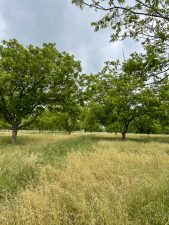
Evaluate Your Expenses to Help Reduce Your Costs
The last several years have been tough for pecan growers with lower prices and higher input costs, and I know most growers are looking for ways to reduce their input costs. To determine where to make the best cuts in your expenses, it helps to understand where you are spending money entirely. For example, do...
Read more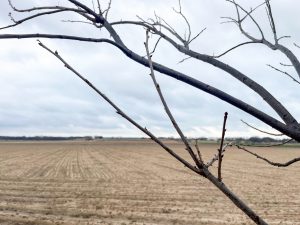
Time to Read Your Trees
As the dawn of a new pecan season rises, there is a bit of a reason for optimism. Of course, every farmer, especially pecan farmers, is an eternal optimist, but it appears the weather pattern may be changing a bit. Areas have received rain and the landscape looks better, but lakes, rivers, and wells are...
Read more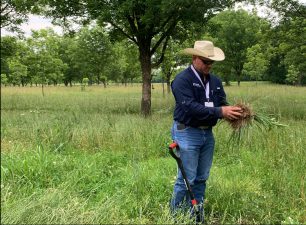
Getting Started in Regenerative Management
I often get asked if we can manage pecans regeneratively and still be productive and profitable. My answer? Yes, we can, but regenerative management will be different for each producer. Each producer will have unique circumstances that will require individualized management practices. Many producers have been seeking ways to reduce input costs while maintaining or...
Read more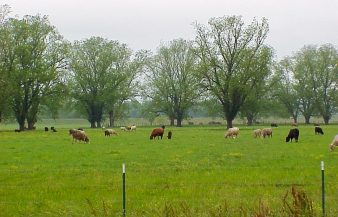
Proper Integration of Livestock can be Beneficial to Soil Health
If handled properly, integrating livestock into an orchard can greatly benefit. As I have visited with growers over the past several years about managing soil health in their orchards, livestock integration is the most common practice pecan growers are hesitant to implement. Knowing how to graze properly to improve soil health is essential for growers...
Read more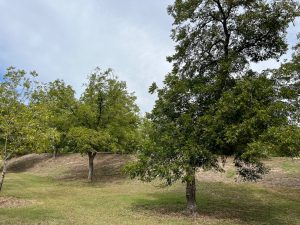
Autumnal Reflections on Drought, Water, and Tree Stress
Ah, fall. At times, it can be the best time of the year, with cooler weather and more optimum working conditions, often after a brutal summer. This year did not disappoint as far as summer heat goes, as we have had a record number of 100-degree days along with minimal rainfall. Of course, the other...
Read more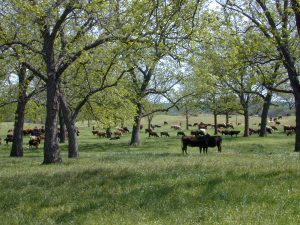
Native Pecan Grove Evaluation
As I sit down to write this article, I am in the midst of preparation for an OSU Extension’s Native Pecan Field Day on the evaluation and management of native pecan groves. So, I think now is a good opportunity to discuss some of the tasks you should be doing as we near another native...
Read more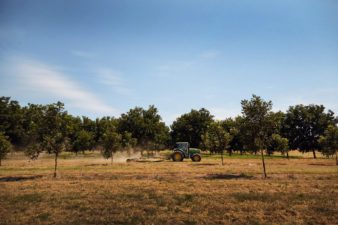
Principles over Practices
Last year, I had the opportunity to attend the Ranching for Profit School conducted by Ranch Management Consultants. While the school targeted livestock producers, I quickly recognized that pecan producers could benefit from a similar school. The school was more of a business course focused on helping individuals (owners or managers) learn how to develop...
Read more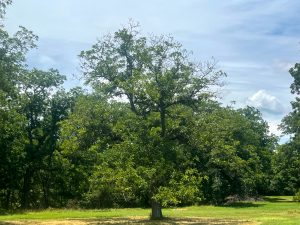
More Heat, More Tree Stress
The heat has been brutal in Texas for the last month or so, but then again, it is summer and supposed to be hot! Typically, pecan trees can take the heat if they have enough water. But now we see signs of stress even on 300-year-old native pecan trees. Most native pecans grow on great,...
Read more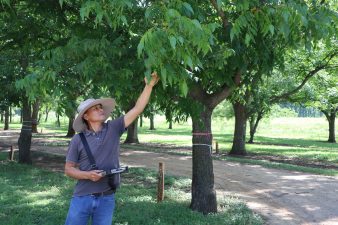
Selecting the Perfect Pecan Tree
What is the perfect pecan tree? Does it produce the best nuts? Does it have disease and pest resistance? What about its size or how long its season lasts? These are questions that stay on the minds of scientists at the USDA-ARS Pecan Breeding and Genetics Program. Like most plant breeding, pecan breeding is the...
Read more
Regenerative Management in Pecans
How can ‘Regenerative Agriculture’ work for pecan growers? Over the last couple of years, this is a common question I have received. I would say that for several of the growers I have visited about regenerative management, most are willing to try it to solve problems that traditional management has not worked on. With higher...
Read more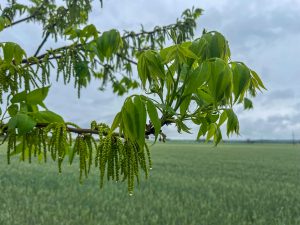
Managing Crop Load in the New Growing Season
It goes without saying—hope springs eternal as we watch buds burst forth with catkins and shoots. No doubt, we ponder hard as to what lies ahead in 2023 in more ways than one. However, we need to concentrate on what we can control, which is not all that much, but at least if we do...
Read more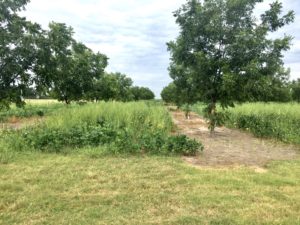
Managing Your Orchards with IPM to Improve Your Profits
As the economic environment continues to change with higher input costs and decreased farm profitability, we as growers must start looking for ways to lessen our dependency on high-cost inputs. Following regenerative agriculture principles has proven to be an effective way to improve soil health and lessen growers’ reliance on high-cost inputs. By following these...
Read more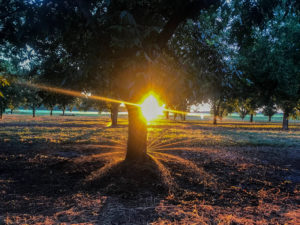
Let the Sunshine in This Growing Season
As we ponder the 2023 growing season, some serious concerns come to mind. Still, having said that, it is really nothing out of the ordinary when it comes to agriculture and the risks farmers take every year. Many times you have to wonder why they would do it. Reckon it is just something that gets...
Read more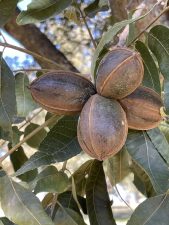
Multiple Stresses Combine and Decrease Pecan Crop
This fall I have received a lot of phone calls and text messages about the pecan crop in the native range, specifically the states of Arkansas, Louisiana, Oklahoma, and Texas. If you hunt down your October issue of Pecan South, you will find estimates of the pecan crop made in June, July, and September, demonstrating...
Read more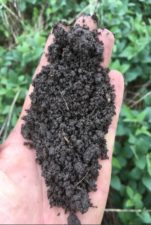
Taking One Small Step Toward More Sustainable Management
For the past year or so, Dr. Graham and I have been writing about changes at the Noble Research Institute and the benefits of soil health. Noble’s new central theme, “Land stewardship for improved soil health in grazing animal production with lasting producer profitability,” guides our objective to “Overcome the barriers deterring the lasting use...
Read more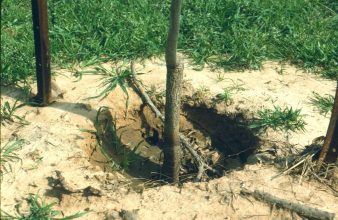
It’s More Than a Lack of Water
We’ve made it through August, and the state of Texas is still immersed in a terrible drought. Typically, the quickest way out of such a situation is to talk about it, but we have been talking about it for months, and little has happened! Perhaps by the time you read this, the situation will have...
Read more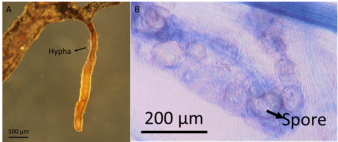
Mycorrhizal Fungi—a potential tool to improve pecan nutrient uptake
A surge in chemical fertilizer prices, especially for nitrogen, has put a lot of pressure on pecan growers. The prices of traditional nitrogen fertilizers have increased significantly since 2019. According to USDA Agricultural Marketing Service data, the cost of ammonia is three times higher in 2022 compared to September 2019, and other fertilizer nutrients are...
Read more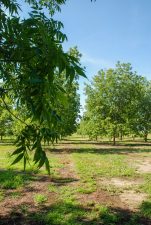
Let’s move ever upward & rethink research’s pairing with observation
Over the past year, as Noble Research Institute has transitioned to regenerative agriculture to improve soil health, I have sat through numerous workshops and educational events and have read literature focusing on ways to improve soil health as well as the benefits of improved soil health. To be honest, at times, it was hard to...
Read more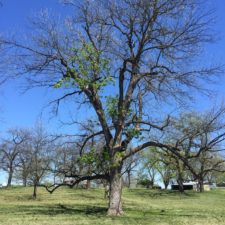
Water woes and tree removal go hand in hand
Like it or not, a new pecan “growing” year is well in hand, despite the continued numerous challenges faced by growers, including rising production costs and labor. Of utmost concern in my mind, though, is the ongoing drought. According to the U.S. Drought Monitor, this drought engulfs about 89.5% of Texas and 44.38% of the...
Read more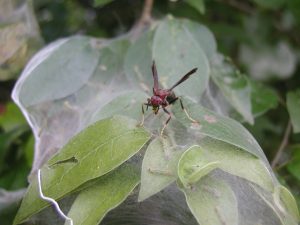
Alternative pest control considerations
With the new season right around the corner and the supply chain challenges for all goods, growers may need to start thinking about alternative pest control options. We have become dependent on chemicals to help control pests in our orchards. This dependence has led to us giving little thought to other methods for controlling these...
Read more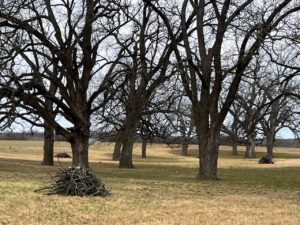
Thoughts for the 2022 crop and growing season
Hard to believe that another growing season is upon us, with spring right around the corner. For some, the coming growing season represents a chance at redemption after a miserable 2021 from the standpoint of a crop or management. One of the greatest challenges that growers face in the upcoming year is the skyrocketing costs...
Read more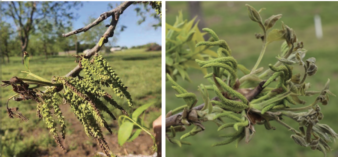
Oklahoma’s 2021 spring freeze impact on pecan flowers
For many pecan growers in Oklahoma, the late spring freeze in 2021 was a nightmare. The hourly temperature ranged from 29-32 degrees Fahrenheit over six hours at the experimental orchard in Perkins, Oklahoma; the damage to pecan flowers was devastating (Fig. 1). Do cultivars react differently when exposed to spring freeze? Pecans exhibit heterodichogamy, meaning...
Read more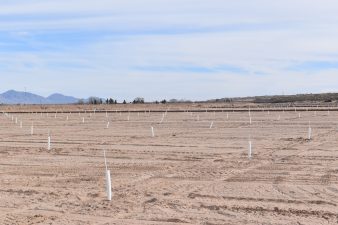
Take years off orchard development with these 5 facets of pecan culture
The elephant in the room for anyone deciding whether to start a pecan orchard is the lengthy non-productive development phase in the beginning. Ownership must have the financial capability to start and care for a new pecan orchard enterprise for a period of four to eight years with no crop. I present this wide four-year...
Read moreIt’s about time (and pecans)
Time is money. Time flies. Time waits for no one. Time changes everything. Time is running out. Popular sayings about time are abundant because we talk about time a lot. We talk about time a lot because we frequently have one eye on time as we go about life. One year ago, my own time...
Read more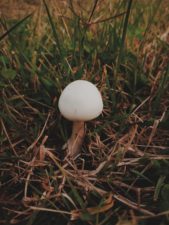
Fungi and bacteria are the keys to soil health and crop production
In the article “Soil Health: Does your orchard need a checkup?” from Pecan South’s June 2019, Dr. Charlie Graham wrote about the importance of fungi for improved soil health. The article did a great job explaining the different types of soil fungi and their benefits. However, you may still be asking yourself why fungi are...
Read more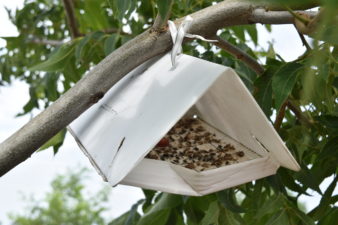
Take that first step toward regenerative agriculture
Over the past few months, I have been through several trainings on regenerative agriculture. I have had the opportunity to visit with several growers interested in a different way of managing their operations and the same questions keep coming up: What does regenerative pecan management look like? I do not know how I can do...
Read more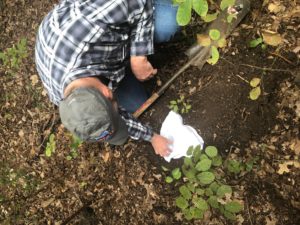
Get to know your soil and your soil health
We all know the importance of monitoring and scouting pecan trees. We spend countless hours each year going through the orchards scouting for disease, insects, nutrient deficiencies, and other issues. In fact, many producers can tell me about each tree without looking at a map or plot plan of the orchard. You can easily recite...
Read more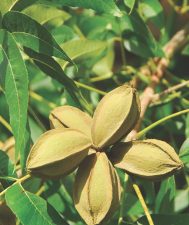
Market timing your pecan production? A questionable decision.
The career of a Wall Street stockbroker is no doubt fast-paced and high stress. Constantly deciding “Should I buy or sell?” or “Is the market heading for a crash or a boon?” must undoubtedly translate into hard days and long, sleepless nights. I had a brief flirtation with buying and selling stocks during the Dot-Com...
Read more
Noble Research Institute focuses on regenerative agriculture
If you have been paying attention to the news or social media lately, you have seen a lot of talk about mitigating climate variability. There have been several different approaches mentioned to accomplish this in agriculture, including organic, sustainable, carbon farming, and regenerative. The Noble Research Institute has announced that we will be focusing on...
Read more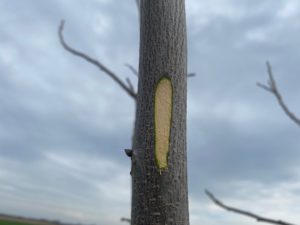
Pecan trees and freeze damage, assessing and monitoring your orchard after the freeze
“Hurry up and wait!” A phrase I have come to say more often than not in the last few weeks. What seemed like an early spring was squashed by an unbelievable Arctic Express in mid-February. For the most part, I think that we as pecan growers are ok, but then again nobody knows that for...
Read more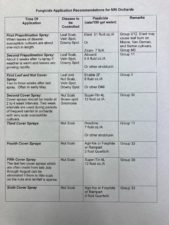
Manage Inputs When Managing Your Orchard
With the current market issues with pecans and the ever-increasing costs of inputs, growers are always looking for ways to increase profit from their pecan operations and manage inputs. We can use several strategies to reduce costs in our operations, hence increasing profit. Some of these strategies may be straightforward, while others may require you...
Read more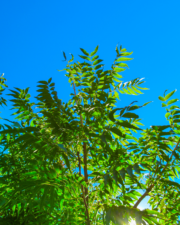
Grow Leaves, Grow More Pecans
Perhaps you remember that well-known line from the poem “Twas The Night Before Christmas”—While visions of sugar-plums danced in their heads. This January, thoughts of lush, dark green leaves sprouting on your pecan trees should be dancing through your head. It’s somewhat hard to think about leaves in January, but growing leaves is exactly what...
Read more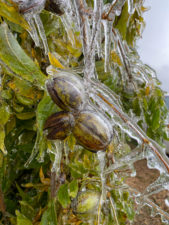
Recovering from Ice Storm Damage
As if 2020 has not been challenging enough, some growers in the central region are facing yet another challenge. Some growers now confront cleaning up orchards following a significant ice storm and trying to salvage what crop they have left. A strong winter storm pushed through North Texas and Oklahoma on Oct. 26 and brought...
Read more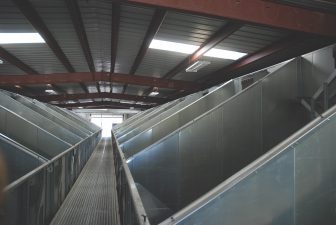
Cleaning & Drying Your Pecans Can Impact Your Profits
Well, it must be time to harvest pecans. For the last few months, spotting a squirrel, crow, or pig in the orchard was an uncommon event, but now a trip to the orchard almost guarantees a photo-op for a few crows or squirrels, and even though you may not see a pig, you can sure...
Read more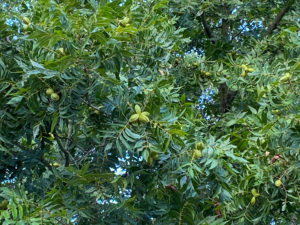
Getting a Handle on Your 2020 Crop
How can it be that it is harvest time once again? It seems that time is flying in these uncommon times! Still your pecan trees have carried on, despite the current challenges. Hopefully, you have been able to keep up with your tree management program and develop a plan to manage your crop load as...
Read more
Pecan Industry Incentives Can Attract Consumers
If this year has not taught us anything else, it has taught us that we live in an ever-changing world. To be successful, we need each other. From growers to accumulators to shellers, we all need to be on the same page for not only marketing pecans but also educating consumers. Recently, I sat through...
Read more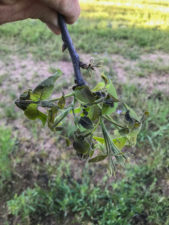
The Woe of Winter in the Heat of the Summer
Once again, growers in the Central region were ready to start another pecan season. The producers were prepared to put the previous season in the past and forget about the low prices they received for this last crop that did not live up to their earlier hopes and expectations. The 2020 season started earlier than...
Read more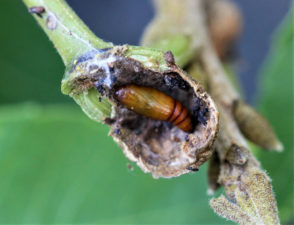
Hickory Shuckworm: An Almost Season-long Pest of Pecan
Despite it being a major pest of pecan, the hickory shuckworm has had less research done on it in the U.S. over the last 20 years than other major pests, including the pecan weevil, aphids, pecan nut casebearer, and stink bugs. Bill Ree, a retired Texas A&M AgriLife IPM specialist, made a similar comment five...
Read more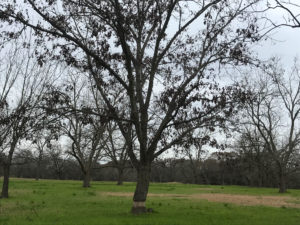
Here Comes the Sun
As a new pecan growing season begins in earnest, I hope you have your management plan for the new year firmly in your mind. Now is the time to think about the moments where you dropped the ball or the things you did not do so hot on. Perhaps you were late with a spray...
Read more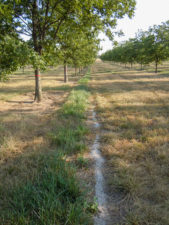
Before You Fertilize, Understand What Your Trees Need
With the 2019 harvest behind us, it is time to get ready for the 2020 crop. Whether you are growing natives or improved cultivars, one of the first management decisions you need to make is your fertilization plan. Nutrient management is one of the most crucial tools to optimize pecan production. A nutrient plan must...
Read more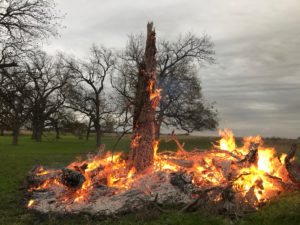
You’ve got brush to burn. Here’s how to do it.
As the harvest season winds down for another year, we are often left with mounds of limbs, which need to be handled by being moved or perhaps burned in place. Such litter is the result of the shading out of branches, broken limbs from either too many nuts and leaves, wind damage due to the...
Read more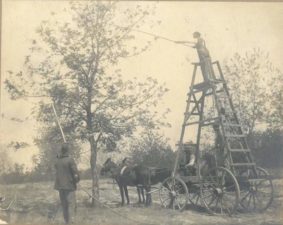
The Origin of Improved Pecans
After writing my last article on “The Importance of Native Pecans for the Future of the Industry,” I have had several readers visit with me about the article, telling me how much they enjoyed it and many saying that it gave them a great appreciation for natives. I have had a few ask me to...
Read more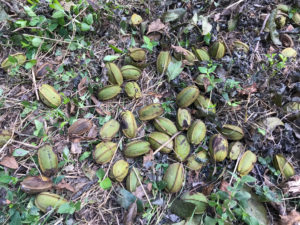
How to Maintain Pecan Kernel Quality Year After Year
As you ponder the quality of this year’s crop, you need to think about what goes into producing quality pecans. Producing top-quality nuts used to seem easy and simple, but as your trees grow and age, consistently growing quality kernels becomes more challenging. The difficulty increases when you add in the fact that no two...
Read more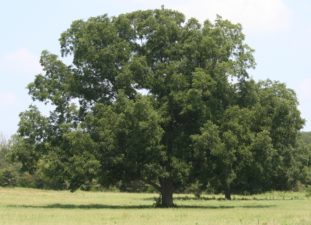
The Importance of Native Pecans for the Industry’s Future
Over the past several years, native pecan production has come under question with many people wondering if natives are a thing of the past. I have heard people say and have read articles that suggest native pecans will not be a viable enterprise in the future. These statements greatly concern me, as I know the...
Read moreFilling your pecans requires you to control & manage what you can
As the dog days of summer encroach upon another pecan growing season, it seems like we are always talking about water—either there’s not enough or way too much! Just like every year, some places across the Pecan Belt have had excessive amounts of rain, whereas other orchards have been getting just enough. The big difference...
Read more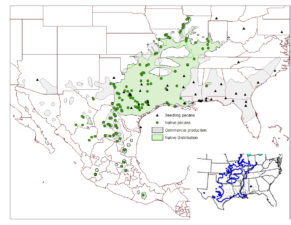
Family Trees: Roots & Resilience
The U.S. pecan industry is young compared to most tree crops. The pecan is an unusual example of a North American native tree that has become a worldwide crop. The early pecan industry grew out of the native forest with several factors contributing to its historic development: a nutritious, high-quality product that was in demand;...
Read more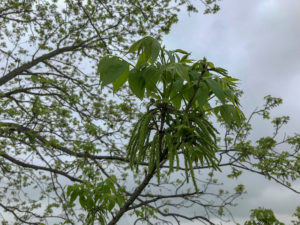
Fertilizer Keeps this Season’s Optimism Alive
Still smarting from quality woes and lack of market activity this past growing season, producers are struggling to find optimism as the new growing season kicks off in earnest. I must admit that I too am struggling for optimism, but in reality, all farmers—whatever the crop—are eternal optimists. Why? Because we have some assurances that...
Read more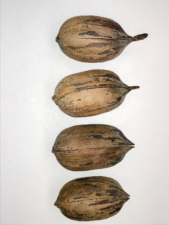
What happened to my 2018 pecan crop?
Pecan production is never an easy or guaranteed venture. Even before the 2018 pecan season started out, most areas had high expectations for a good crop. Crop production was lower the previous season, and for most of us we, had good soil moisture over the winter. However just as the 2018 season started with some...
Read more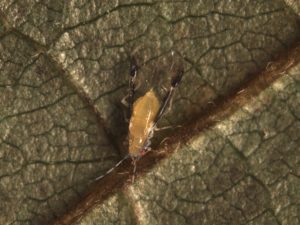
Pecan Aphids, Part I: Distribution on Pecan Leaves
This article is the first of a three-part series examining the pecan-feeding aphids, especially the black pecan aphid. This first part concerns the general biology of the pecan aphids and their distribution on pecan leaves. In the second part, the emphasis will shift to the black pecan aphid with a discussion of feeding biology, and...
Read more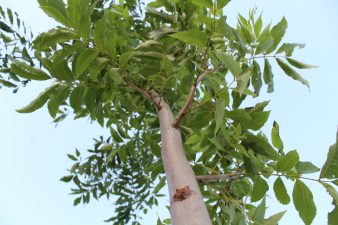
Good Pecans Start With Good Leaves
As we stand on the threshold of the 2019 growing season, it would be easy to be discouraged after the challenges we have had the last couple of years, but we all know that if it was easy, anyone could do it and we also know that growing pecans is a lot of hard work!...
Read more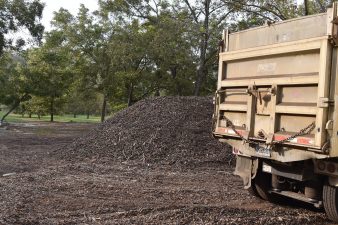
More than a tree
We all know that the wood from pecan trees is great for barbecuing and smoking meat. Along with adding flavor to your meats, pecan wood makes unique furniture, flooring, and paneling. It is also used in producing pallets for transportation of goods. After pecan wood is cured, it is extremely durable. Pecan wood has also...
Read more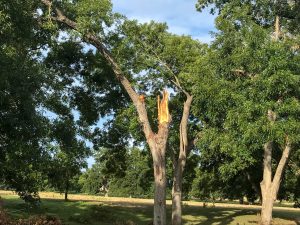
Seasonal challenges augment the effects of overcropping
The challenges of agriculture are never-ending. From being too dry to being too wet to being too cold and always too hot, and then throw in a few hail storms, tornados, and hurricanes! Most everyday folks would never dream of taking the risks farmers take on a daily basis. Then, couple all of that with...
Read more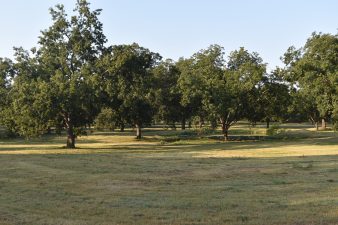
Pre-Harvest Planning
Since harvest is just around the corner, I thought it would be good to talk about management practices a grower may take the time to evaluate this time of year, which could pay big dividends into the future. I know that many producers are focused on the upcoming harvest and getting their equipment ready. However,...
Read more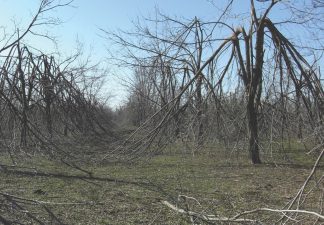
Orchard cleanup following ice damage
Many native pecan-producing areas were recently hit with extremely low temperatures and a blanket of ice. Producers can only hope any damage is not to the extent that has resulted from ice storms of the past. One major factor that could increase the potential for damage is the amount of stress that the trees have...
Read more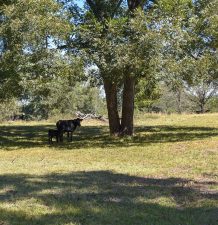
A Tale of Two Enterprises: Pecans and Cattle
Regardless of the total acreage of a pecan grove, the trees themselves occupy only a small portion of the physical ground space most of the time. This leaves much of the total acreage as simply ground cover, usually grass, which can be maintained by regular mowing or haying of the grove floor. Many producers choose...
Read more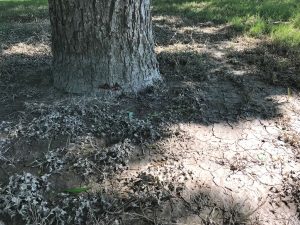
A Happy, Healthy Native Tree Makes for a Potentially Prosperous Crop
Texas has many, many native pecan trees. In fact, we like to claim that the pecan originated in Texas! These trees are located on some of the very best pecan soils in the world—deep, well-drained, fertile and typically with a static water table at about 20 to 25 feet. However, in the grand scheme of...
Read more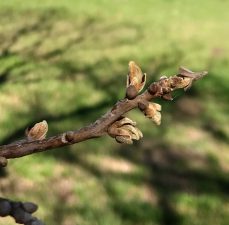
Watch for Freeze Damage This Chilly Spring
As I was preparing to write this article, I was pondering what to write about this month but then mother nature gave me an unexpected and unwanted topic. Over the weekend of April 7 and 8 temperatures across the northern pecan production areas dropped below freezing. With budbreak having started on several trees in southern...
Read moreTree by Tree, Step by Step
What a difference a year makes as we get ready for another exciting growing season! Our winter to date has been totally different from last year with periods of extended cold, some ice and snow and cold fronts on a regular basis. After a year of virtually no chill, it appears that we will have...
Read more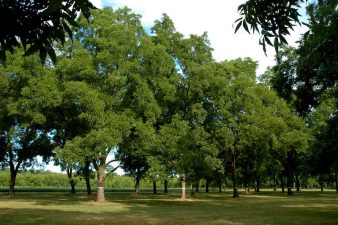
A Brief History of Native Pecan Production in Kansas
We just finished up harvesting, cleaning, and marketing our 2017 native pecan crop. At this point in the season, I usually take stock of how our natives performed during the previous growing season and then make plans for how we can tweak our management program to optimize the 2018 crop. Do we need to alter...
Read more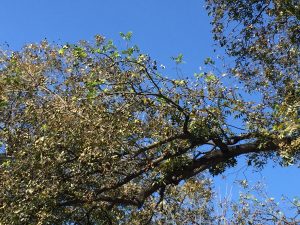
So, what happened to my pecans?
Hard to believe another year has come and gone, and with it, another pecan harvest of some pretty iffy pecans in some areas of the state. Although other folks had very good pecans, the norm for many areas of Texas has been only fair to good pecans. Please, please, don’t get me wrong. I am...
Read more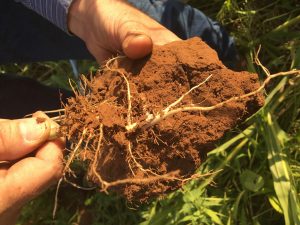
Improving Soil Health Through Cover Crops for Pecans
Recently, there has been a lot of attention centered on soil health. While the importance of soil health is not new to pecan producers, I believe this is an area where we as producers can definitely make improvements. As I travel and see different operations and visit with managers about their management practices one thing...
Read more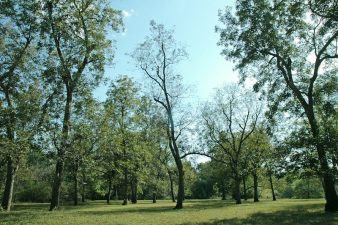
A Short Drive, A Chance to Scout the Native Crop
I was driving along backroads through native pecan groves when I came across a stopped pickup and a guy standing out in the middle of the road with a pair of binoculars trained on the upper branches of nearby trees. Turns out, I interrupted a pecan buyer trying to get a feel for the nut...
Read more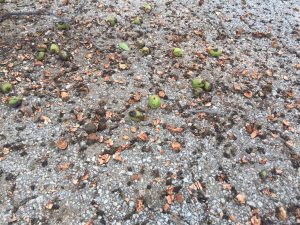
When the Storm Ends, Cleanup Begins
The dawn of the 2017 pecan harvest is upon us. As usual, it has its own set of unique challenges, which must be dealt with depending on where you are before one could even think about harvesting. First and foremost, many pecan bottoms were flooded due to Hurricane Harvey, and the cleanup of the debris...
Read moreScorched
Uncovering why leaves die can be a complicated business. Many symptoms are similar, but they can have very different causes. Is the dead tissue a primary or secondary symptom? Are we talking about a disease, insect, nutrient, or even something entirely different? As Dr. Cary Illinois finds out, diagnosing leaf scorch symptoms can sometimes be...
Read more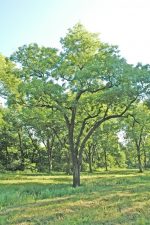
The Story of a Good Native Nut
I don’t think I’ve ever visited a native pecan producer that doesn’t have a favorite tree in their grove. More than likely, he has propagated additional trees of the family’s favorite native pecan with the dream he’s discovered the next big pecan cultivar. I’ve seen a lot of these nuts and they seem to have...
Read moreCrop or Not, Make Your Native Timbre Happier and Healthier
It is hard to believe we are already in the middle of another growing season. Just as they always are, this year has been anything but normal. First, there was the protracted bud break period due to the lack of adequate chilling hours. We had a couple of Arctic Express cold fronts this past winter,...
Read more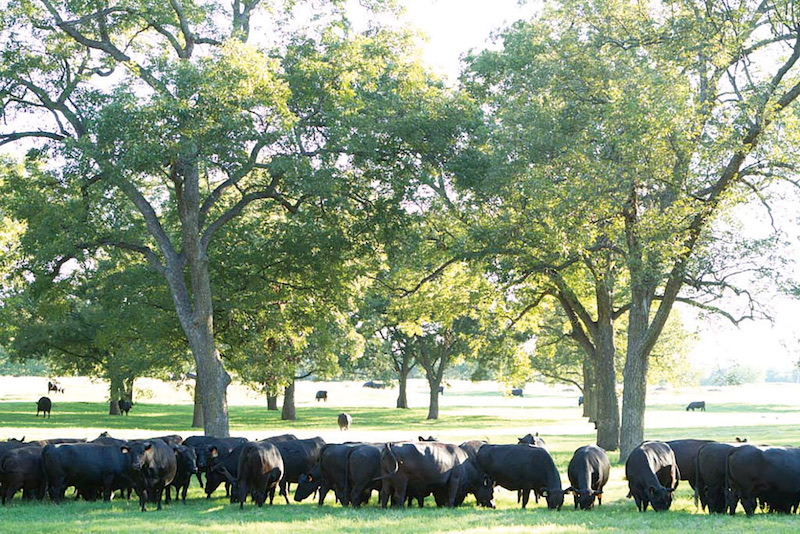
Add Value in the Pecan Orchard with Ground Cover
When I am visiting with pecan growers, one topic that seems to come up is proper management of forage for either livestock grazing or for hay production. Working mostly in Oklahoma and North Texas, the majority of the landowners I work with are not just solely pecan producers. These individuals are agriculture producers with diverse...
Read moreThe Tree Signals the Timing for Orchard Tasks
“When do I fertilize?” “When do I spray for casebearer?” “When do I control pecan weevil?” These are just a few of the ‘when’ questions I field every year from both new and experienced pecan growers. And with an early spring this year, everyone seems confused about timing orchard operations. I could reply with a...
Read moreUnique Winter and Early Spring Weather
The dawn of a new growing season is upon us once again; it really seems like we just finished the last season and here we go again. What a unique winter and early spring it has been—hardly cold in some areas, but still those areas had two arctic blasts and the cold from those spells...
Read more
GM? NO. (But does it matter?)
Sometimes our eyes can betray us. The connection between what we see and what we know is very strong. Each feeds the other – seeing something adds to our catalog of knowledge, whereas having knowledge of something prior to seeing it can sometimes be limiting. An illustration of this occurs in the next case by...
Read more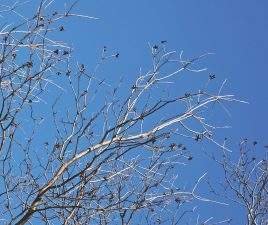
Gauge Native Potential by Branch Growth Pattern
The winter months are usually a time to wrap up marketing last fall’s pecan crop and get ready for a new pecan season. But recently, I took a short drive down the gravel roads in the Neosho River bottom to take a look at native trees in mid-winter. Along the road, I passed native groves...
Read more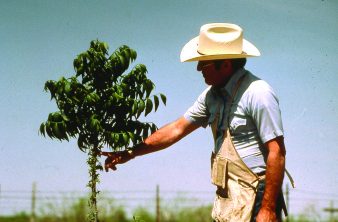
A Farewell Salute to Sammy Helmers
It is once again time to bid a final farewell to one of Extension Horticulture’s finest: Dr. Sammy G. Helmers. It seems the Good Lord was in need of a new “storyteller” and our own Dr. Helmers was called in for the job on Nov. 15, 2016. Since we are talking about our one and...
Read more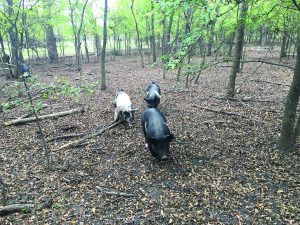
Alternative Thoughts on Thinning Out Native Pecan Bottoms
With the increased interest in pecans, I have received several calls over the past 2 years about how to clear native pecan bottoms to bring them into production and start a pecan enterprise. During these discussions, I normally recommend using heavy equipment to clear these bottoms of undesirable tree species and underbrush, and thinning out...
Read moreInvest in Your Native Pecan Trees
All too often I hear native growers complain that they have little or no crop because wet weather in the spring prevented pecan pollination. The truth of the matter is that a few rain storms during pollination rarely prevent nut set in native groves. When someone complains about lack of pollination, I immediately suspect the...
Read more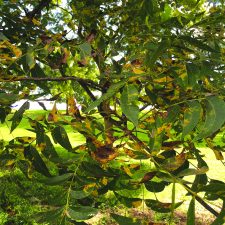
Stay on Top of Pest Monitoring, Shading Issues
As this Labor Day came and went, I couldn’t help but think of my good friend Horace Brown, now deceased, and his first pecan pie of the season. The Browns had some of the earliest ripening native pecans in the country, and so, Horace was not content to have an apple pie for Labor Day,...
Read moreCase 3: Crowd Control
Most scientists don’t get too personally attached to the plants they work on because sooner or later they will likely be cut down or otherwise destroyed. However, most other humans look at a full grown tree and think, “You want me to do what? Cut it down? Are you crazy?” What’s best is not always...
Read more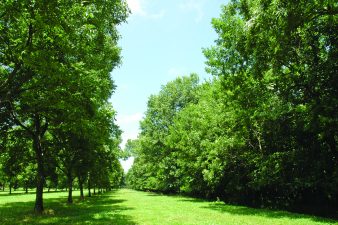
Be Aware of Edge Effects
The other day I was up at our local pesticide distributor to pick up some chemicals when I got into a conversation with a neighboring row-crop farmer. The topic of deer damage came up, and he mentioned that every year deer create the same unique browse pattern along the edges of his fields. That simple...
Read more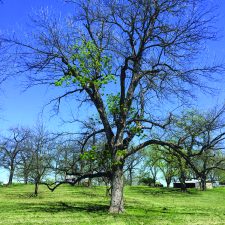
Rain Can Bring Blessings and Challenges
Rain!!… what a beautiful thing… just seems to be too much at times. But, my, does it make things grow, especially pecans. It seems like we have been talking about drought and the devastation it was having on native trees along rivers and creeks that had gone dry forever, and today we are talking about...
Read moreExamining New Concepts With Soil Health and Pecan Orchards
I recently was asked to discuss improving soil and root health in pecan orchards at the Comanche County Pecan Workshop in Texas. During my research on this topic, I discovered that soil cover, soil disturbance and plant diversity are often overlooked, but are critical in the production of pecans. There is a lot of literature...
Read more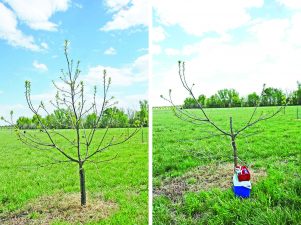
Bark Grafting in the Native Grove
Most native pecan growers have areas in their groves that have dozens of young trees along fence rows or popping up in open areas among mature trees. Fence-line pecan trees are often moved using a tree spade into open areas of the grove to help fully utilize available land area. The bottom line is that...
Read moreThe Annual Challenge of Managing Water in Pecans
I recently had the honor and privilege—probably the right term is challenge—to expound on pecan water requirements in a court of law. Those of you who practice that profession and/or those of you who have done that sort of thing in the past know exactly what I am talking about. The real question is where...
Read moreWater Management in Pecans is Annual Challenge
I recently had the honor and privilege — probably the right term is challenge — to expound on pecan water requirements in a court of law. Those of you who practice that profession and/or those of you who have done that sort of thing in the past know exactly what I am talking about. The...
Read moreSymptoms of Deception
Sometimes the symptoms we see with our eyes do not always provide an obvious link to an answer. And sometimes, what we think we know does not provide the answer because we are limited by our own knowledge. The biological world is a complex environment and often factors interact to bring about a certain result....
Read more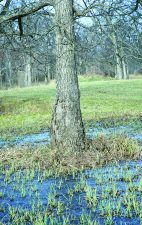
The Causes of Lower Trunk Swelling
I have visited many native pecan groves over the years and have always found at least one tree in each grove that has developed a swollen, disfigured lower trunk. Trees with this condition are typically weak nut producers and often suffer from significant limb loss. As I work with growers to improve their native groves,...
Read moreShortcourse Offers Basic Management Overview
I never cease to be amazed at the power of water… and today we are not talking about flooding, but rather the power to make things grow! Trees given up for dead made unbelievable growth in 2015. We always tell folks that if they want to grow pecans, they have to get their “water right!”;...
Read more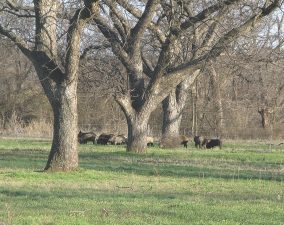
Feral Hogs in the Grove
Feral hogs are among the most destructive invasive species that agriculture producers face and can be a major issue for pecan growers. The most obvious damage that hogs cause in pecan areas is damage to the ground that interferes with harvest and general management. While this destruction can be costly and time-consuming, one often-overlooked consideration...
Read more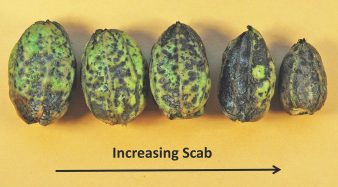
Thinking About Scab at Harvest Time
By mid-September, the limbs of our native trees were bending down under the weight of an excellent nut crop. But it wasn’t until the leaves fell in early November that I could really see the size and quality of the 2015 crop. Back in 2012, extended drought shrank the size of our native nuts causing...
Read moreDawn of Another Native Harvest Season
The dawn of a new harvest season is upon us; in fact, the varmints have already captured those early maturing native pecans. More times than not, they get them long before we even know they are ready. What a crazy year it has been again — starting off wet, almost too wet in some areas,...
Read moreThe Pecan Detective Agency
When I was much younger I wanted to be a private detective. I read many of the old detective novels and watched lots of movies, hoping to be just like Sherlock Holmes, Hercule Poirot, Charlie Chan or Inspector Wellman (bonus points if you know the last one). I was intrigued by how the detective was...
Read more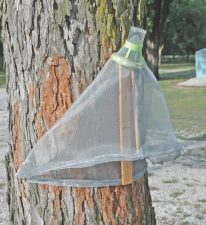
Building Pecan Weevil Circle Traps
Pecan weevil is the number one pest of native pecan growers. Knowing when to spray for this pest is critical for achieving economic control of a weevil population. To help make weevil spray-date decisions, we have been using trunk-mounted ‘Circle’ traps. When placed on known “weevil trees,” these traps are very effective for monitoring pecan...
Read more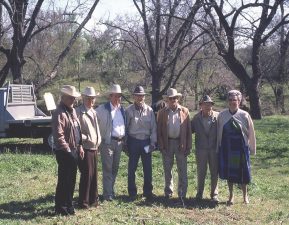
Bluefford Hancock – Pecans were his true love
I was privileged to have been hired by Mr. Bluefford G. Hancock, Extension Horticulture Project Group Leader Emeritus for Texas A&M AgriLife Extension Service, better known as the Texas Agriculture Extension Service in his heyday. As Mr. Hancock often remarked, “When he started out he was the only one (Extension Horticulturist for Texas)”; and he...
Read moreHas rain washed away the pecan crop?
As I sit down to write this article, the spring season is coming to an end. Catkins have come and gone, and most trees are finished shedding pollen for the year. Normally, I would have spent the last couple of months watching my wife and kids suffer through another miserable allergy season in Louisiana. But...
Read more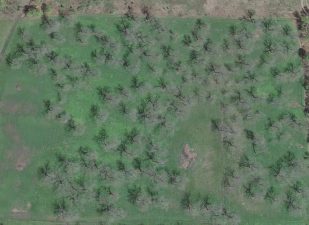
Tools to help determine a thinning plan
Mature tree removal is one of the most critical and difficult management decisions that a pecan grower has to make particularly in native groves. It is often very difficult for a producer to cut down a large tree. Sometimes this difficulty arises from an emotional connection to a tree and other times it can be...
Read more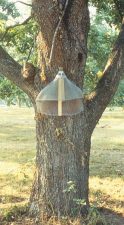
Native Pecan Management During an “On” Year
In many native pecan groves, 2014 was a short crop year. A late spring frost in April 2014 damaged emerging buds and limited pistillate flower production. Then, just as the harvest season began, the weather turned crazy. We started with snow in early November then had periodic rain and snow storms during much of the...
Read more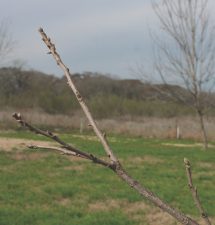
Keys to consistent native production
It is hard to believe that the dawn of another growing season is upon us — seems like we were just talking about harvest and now it is time to start all over once again. No doubt the “old timers” got it right when they said, “the older you get the faster the years go”!...
Read moreDormant Season Activities to Improve your Orchard
In last month’s Pecan South, Blair Krebs provided us with an overview of the status of pecan harvest in various locations in the pecan belt. With it appearing that most growers have completed harvest for the 2014 season and hopefully have also sold the crop at a satisfactory price, I hope you had time to...
Read moreC-hican-ery
While I write this, we are in the midst of an election. Never-ending political ads blur the television screen and radio waves. Ceaseless mud-slinging and overt bashing of opponents is seemingly the only way races are played out in the public these days. It’s enough to make your eyes and ears bleed. Yes, 2014 is...
Read more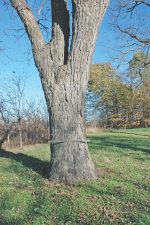
Native Pecans: a history of tree growth and yield
One of the jobs I look forward to each fall is shaking trees in our native grove. Driving from tree to tree with the shaker gives me the opportunity check tree health, and as I shake the tree, the sound of nuts hitting the tractor’s roof gives me a good feel for this year’s production....
Read more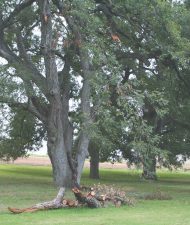
Crop is good but varmints lurk
Whew! Looks like we are going to make it! Yes, as harvest begins it appears that the crop is going to be good despite the weather challenges. Many growers related that they were not sure they could make another season if it didn’t rain soon last year (2013) and even though there has been a...
Read moreMarketing for the small pecan grower
Over the past few years, the U.S. pecan industry has seen continual growth and strengthening in the export market. Some credit has to be attributed to USDA programs that support American producers and businesses. Specialty Crop research grants and state Block Grants, crop insurance, and Foreign Agricultural Service marketing programs have all helped to strengthen...
Read more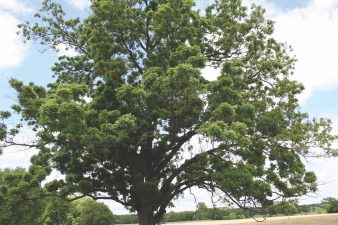
Review of Bunch Disease in Pecan
During the Oklahoma Pecan Growers’ orchard tour during the last conference, we looked at several pecan trees that exhibited signs of bunch disease. Producers asked several questions about this disease during the field tour and I have received several questions since. There is not a significant amount of information regarding bunch disease in pecan. The...
Read more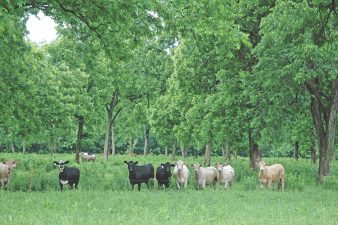
Impacts of grazing cattle in a pecan grove
One of the most common forms of ground cover management in native pecan groves is to pasture cattle (Fig. 1). Grazing offers 2 advantages for a pecan producer: a second source of income from the same parcel of land (pecans + beef) and a significant reduction in orchard mowing costs. The grazing of animals under...
Read more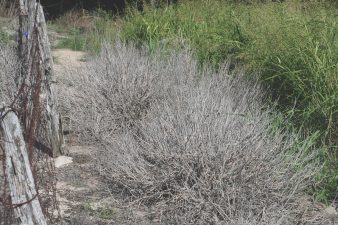
Exercise caution with weed, brush control
Unexpected rains have been nice across much of the state; that, coupled with a very heavy bloom in native pecan bottoms, is cause for optimism even though a late freeze greatly reduced the crop load in some areas. However, pecan nut casebearer has been quite low to non-existent in many areas. So theoretically we should...
Read moreDid you forget about the FSMA?
Everyone has to do it. Papers pile up on your desk for a few weeks and you have to take some time to straighten up your mess before you get buried under it. As I was sorting through a rather large pile of Food Safety Modernization Act (FSMA) materials, I realized it had been over...
Read moreThe Power of Association
As I write this, the Southeastern Pecan Growers Association annual convention is going on in Biloxi, Mississippi. Unfortunately, I can’t make it but I’m sure it will be a successful event. The opportunity for growers to get together and discuss pecan production practices is always enlightening. The education received is invaluable. Another important aspect is...
Read more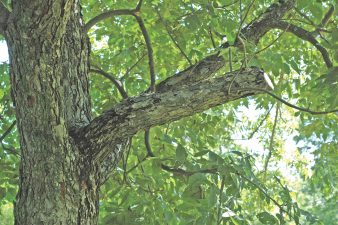
Natural limb pruning
When visitors come to this corner of Southeast Kansas and walk in the shade of our native pecan groves, they are most often impressed by the enormous size of the trees. One of the first questions that always pops into a visitors head is: “How do you prune these huge trees?” I explain that the...
Read moreWinter brought good chilling but drought continues
We are off and running on another pecan year and many folks are looking forward to the New Year after the poor crop in 2013. What a winter it has been to date – unbelievable cold weather. Not so much from extreme lows, but rather from extended periods of cold weather. All temperate fruit crops...
Read moreCan’t find a tree to buy? Grow your own!
Has anyone tried to buy a pecan tree lately? You almost need to hire a private investigator to track one down for you. I’ve been receiving numerous inquiries from growers frustrated with their search for the appropriate variety on the right rootstock. Because of the explosion in new pecan acreage the last few years, nurseries...
Read more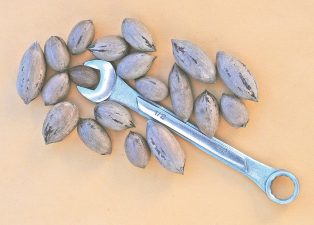
A Good Year to Mark Trees
The hot dry summers of 2011 and 2012 had a major impact on native pecan size and quality. In my area of Kansas, the dry weather shrank nuts down to about three quarters their normal weight. Fortunately, we received just enough late-summer rain during both years to promote full kernel development. By harvest, we were...
Read moreA – n – t – i – c – i – p – a – t – i – o – n
Some of you remember the Carly Simon song “Anticipation” from years ago. It was the most famous track from her 1971 album of the same name, reaching #13 on the U.S. pop charts. The song relates Simon’s state of mind as she waits to go on a date with Cat Stevens. And just as Ms....
Read moreA Season of Extremes
While growing up in Texas, I was used to hearing the phrase “If you don’t like the weather in Texas, wait five minutes — it’ll change!” A similar statement is credited to the legendary Will Rogers, “If you don’t like the weather in Oklahoma, wait a minute and it’ll change.” However, this summer many pecan...
Read moreFire and Pecan Trees
Recently I read about the enormous fires that were burning in Colorado. I’ve visited that area of the state a few times and always found it fascinating. When I was younger I was in Yellowstone National Park when the historic fires burned there. Fire definitely has a way of changing the ecological landscape. It has...
Read more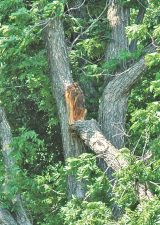
Identifying causes for trunk injuries
It’s mid-summer and there’s not much to do in the native grove except for clipping the ground cover. The other day I noticed a large limb had been ripped out of a native tree by the wind (Fig. 1). I thought to myself—“now that mess will be a hot job to clean up”. If you...
Read moreEven Natives May Succumb to Extended Drought
Water… the basic premise of life, a fact that applies to both animals as well as plants. As anyone involved in the production of pecans knows, water is critical for tree growth and health, and most importantly to ensure nut development and fill. In fact, when most good pecan men are asked to name the...
Read morePesticide Drift Affecting Pecan Trees
With twin 5-year-old girls in the house, it is a pretty common occurrence for me to be reading a children’s book, including nursery rhymes. Most parents have probably read the poem: March winds and April showers bring forth May flowers. It’s a cute little poem, but after working in agriculture the last few years, a...
Read more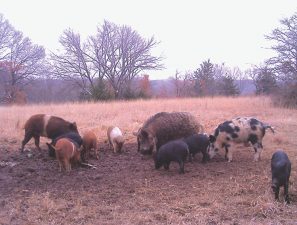
Feral Hogs: A hidden danger among food safety concerns
There has been a lot of talk about food safety and as you read in Charles Graham’s article in February, “New food safety regulations on the horizon,” several of the new regulations were discussed. Food safety is a major concern for all industries and it may take only one outbreak to greatly affect the future...
Read more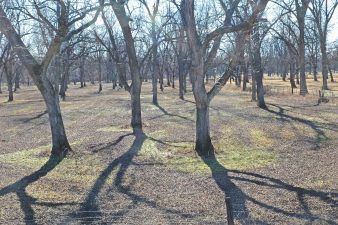
Consistent fertilization leads to consistent nut production
With the drop in prices paid for the 2012 native crop, growers are searching for ways to cut production costs this season. Unfortunately, one of the first production inputs many growers think about cutting is fertilizer. It all starts with a call to the local fertilizer dealer. Urea and potash are still both over $500...
Read moreDon’t get discouraged and push out your natives!
One is sure hard-pressed to find a positive spin for native pecans today even though there was a big crop in 2012. Unfortunately, the drought also continued in 2012 and for some reason, the price for native pecans was pretty pathetic even though the price had been very good the last two years. Still, for...
Read moreNew food safety regs on the horizon
As I sit down to write this article for Pecan South, we’ve just finished up the holiday season and the kids have started school again. It’s a new year and I was pondering the idea of actually choosing a new novel to read over the next few weeks, something I haven’t had the time to...
Read moreThe Diverse World of Hickory
If you are reading this then I assume you know that pecans (Carya illinoensis) are in the hickory family. Pecans are also the “high point” of the family in terms of economic importance. However, there are several other species that might have some value as well if some time and effort was put into their...
Read moreDry weather lessons
The nuts produced in the northern portions of the pecan tree’s native range are known for having bright, high-quality kernels that provide the food industry with great tasting ‘topper-halves’. However, northern natives are not renowned for their large nut size. Over the past couple of years, region-wide droughts have had a major impact on our...
Read moreTexas native crop fairly good despite drought
Even though the drought conditions have eased a bit in Texas, there are still many areas of the state that are in dire need of water despite the fact that rains have fallen in recent weeks. The problem is the rain has been very scattered as many areas only received a “settling of the dust”,...
Read more2012: the year the minors went major
As I write this article, we are at the beginning of another pecan harvest season. ‘Pawnee’, ‘Candy’ and ‘Kanza’ have all initiated shucksplit before Sept. 1, 2012. Therefore much of a grower’s time over the next few weeks will be devoted to getting equipment ready to go out into the orchard. However, try to find...
Read more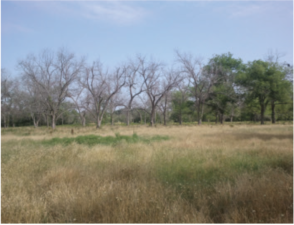
Pecan Trees: Coping With the Drought
During 2011 Oklahoma and Texas endured a severe drought resulting in major agricultural losses. The losses from the continued drought conditions of 2012 could be as equally significant if adequate rainfall does not occur. Drought conditions cause extreme stress on pecan trees. Water is critical for tree survival and nut production and is involved in...
Read more
Weevils in their native environment
Weevil is the number one pest native pecan growers must learn to manage. Every time I think I’ve discovered the magic formula for completely stopping pecan weevil damage, nature throws me a curveball and I end up pulling weevil-damaged nuts off the cleaning table. It seems that managing pecan weevil in a native pecan grove may be...
Read more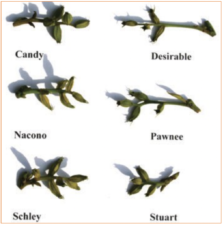
Spring Came Early—Don’t Get Caught Unprepared!
From an astronomical point of view, spring made its earliest arrival in the U.S. since 1896. The vernal equinox (the first day of spring) arrived at 1:14 EDT on Tuesday, March 20, 2012. And just in case you didn’t notice, spring temperatures arrived earlier than that, as some parts of the country experienced spring-like, even...
Read more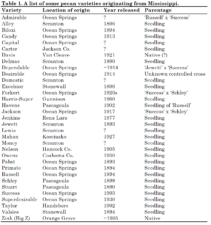
Don’t Call it a Comeback…
The last time I wrote an article I was in Oklahoma. Since then I have moved to Mississippi State University. My position is similar, but some change in crops of major interest. Pecan growers, however, were one of the first groups to latch onto me. You see, just like everyone else in the U.S. the...
Read more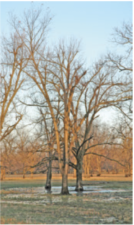
Working on Field Drainage
Last summer’s searing heat and bone dry conditions are still fresh in the minds of native pecan growers from Texas up through Kansas. However, it will not stay dry forever. The rains will return and we’ll soon be talking about cleaning up after a flood in the pecan grove. The fact is we can do...
Read moreFor natives, wait for nitrogen application; be ready with zinc
Even though we have turned the page on a new year, the sting of the 2011 cropping season lingers. For many in Texas, 2011 was their worst year ever. Still, parts of the state enjoyed a favorable native and improved pecan crop. Native pecans produced in 2011 were for the most part quite small due...
Read more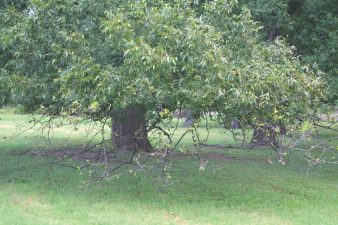
What to expect from your trees after a severe drought
With the 2011 pecan harvest in our rearview mirror, some of you probably had a little extra time to enjoy working on a puzzle. Some like jigsaw puzzles. Sudoku is pretty popular, but it’s tough to beat just like a good old-fashioned crossword puzzle. So, for you puzzle enthusiasts, what is a 7-letter word for...
Read moreNative Treasures
During 2010 over 45 million pounds of native pecans were harvested in the United States. This production had a value of over $60 million dollars. With an estimated one million acres of native pecan timber, there is a huge potential to increase farm income from managing these trees. Often times, native producers do nothing to...
Read moreTaking On More Natives
One thing’s certain in the pecan business. When pecan prices spike, more people get interested in managing native pecan trees. Drive through any native pecan area and you can find stands of trees that look to have potential for profitable pecan production. But looks can be deceiving. Some of these native stands were abandoned for...
Read moreAssessing Your Crop: Bending Limbs and the “Pop” Test
Although most are ready for this year to be over, it is really hard to believe it is harvest time once again. Hopefully, most of you have a few nuts left to harvest after the brutal, horrific summer. Most improved pecan orchards have had to supply every ounce of water the trees got; so with...
Read moreAw Shucks! This Season Just Ain’t Normal
The last article I wrote discussed the flowering process in pecans and the different nut drop stages a grower could expect to observe through the spring and summer months. Now that we’ve managed to keep part of the crop on the trees until September, I thought we would spend some time discussing the effects of...
Read moreRambling on and Pondering Pecan Nuts
As an Extension specialist, I need to be pretty good at observation. I must be able to look at a problem, diagnose it, and file it in my memory for the next opportunity. I also watch people and observe their habits. For example, I listen to what someone talks about, even if it has nothing...
Read moreWater and Native Pecans
Out here in the middle of the country, we’ve been under a dome of high pressure for weeks. Daily temperatures soar above 100 degrees and the sun is baking the field dry. It is even starting to get dry in our native pecan groves. At this point, even atheists are praying for rain. As most...
Read moreWow Will Weather Affect This Year’s Crop?
It should come as no surprise to anyone that the drought is the center of attention in Texas. To make matters worse we just went through May which is typically the wettest month of the year, and as luck would have it, it turned out to be the third driest month on record in many...
Read moreHow Will Weather Affect This Year’s Crop?
If you search on the internet for pecan pollination, you will generally find that pecan is referred to as a wind-pollinated, monoecious crop exhibiting heterodichogamy. What does that mean? Simply that pecan trees produce separate male and female flowers that mature at different times. When pollen is shed before the female flowers are receptive, the...
Read moreOld Grove, New Potential
Last year over 45 million pounds of native pecans were harvested in the United States worth over $60 million dollars. The good prices from the past year have generated a lot of interest in pecan production. I receive several calls each week from folks wanting to get into the pecan business and benefit from these...
Read moreThe Other Pecan Product
The 2010 pecan crop set new records for prices paid to the producers of native pecans. With high prices comes renewed interest in developing new or long-time abandoned native pecan groves. Over the past few months, I’ve spent a lot of time working with landowners ready to get rich in the pecan game (oh, if...
Read moreVast Stands of Natives Could Increase U.S. Production
Record native pecan prices in 2011 have created a great deal of interest in the potential management of native pecan stands in Texas. Despite the good off-year pecan crop in Texas, the native crop was fair to good at best. However, the good prices lead to healthy returns for most folks who manage and/or harvest...
Read moreThe Importance Of Good Soil
Another year has passed us by and I’m sure you’ve heard or read many reflections on the events of 2010. As I sit here, pondering the last year’s pecan season, the overriding message has got to be “Wow, what a difference a year makes!!” Last year (January 2010) we were lamenting over the fact that...
Read moreKnow Thine Enemy
In the book, “The Art of War” by Sun-Tzu Wu, a very famous phrase was used – “know thine enemy”. I’m not sure whether this is a direct translation or just paraphrasing (my Chinese translation skills are seriously lacking), but the meaning is that the better one understands an adversary the better chance one has...
Read moreNative Trees Recover from Ice Storm Damage
The older I get, the more respect I have for the durability of our native groves. Wind, floods, drought, freezing temperatures, and ice storms have all pummeled our native groves. But following every natural disaster, native groves recover and grow back into productivity. Sure, we lose some trees along the way, but our younger native...
Read moreSteps to Protect Your Pecans This Harvest Season
The 2010 harvest season is here! Even though it is hard to believe it is here so soon, it also seems like it has been a long growing season. Growing conditions have been favorable across the state for most of the year with good and at times too much rain. Still there are places that...
Read moreSteps to Protect Your Pecans This Harvest Season
It’s finally here! After spending months caring for and trying to protect your pecan crop, it is almost time to reap your rewards. Most varieties are in the final stages of kernel filling and soon it will be time to start harvesting. It is the time of year when most individuals involved in the pecan...
Read moreWildlife Can Take Significant Toll on Pecan Crop
Pecan groves seem to be a common gathering place for a variety of wildlife. Often times, individuals find this visually appealing when in fact wildlife gathering in these areas can become quite a nuisance. The damage resulting from wildlife inhabitation can be divided into three areas: tree injury, nut injury, and cashing. Tree injury occurs when the...
Read moreNative Disease Management
Ever since the 2007 Easter freeze, it seems like we have had to re-adjust our thinking about pest management in native pecans, at least in the northern portion of the native pecan range. It seems like the freezing temperatures in the spring of 2007 not only destroyed all the emerging new shoots on our trees,...
Read moreNative Crop Looks Good in Texas So Far
It is with a great deal of sadness and respect that I note the passing of Belding Farms pecan grower extraordinaire, Mr. Jim Bennett. The first time I visited Belding Farms I was not only intrigued with the trees, but the size of the operation and the smoothness with which it ran due to Mr....
Read moreSuccessfully Managing Native Pecans Can Be Challenging
One of the most challenging aspects of pecan production is managing the native pecan grove. Native pecan groves are unique since no two native trees or orchards are alike. Since these differences exist, each grove must be managed differently. To successfully manage a native grove, a producer should take a holistic approach when evaluating the...
Read moreA Walk In The Grove
It was a long cold winter. When the weather finally broke with a warm spell in mid-March, I decided to enjoy a moment of warm sunshine to walk the grove. This has become a sort of annual tradition with me, looking over the trees and reflecting on all the things we did right and all...
Read morePecan Graftwood Collection
Have you ever found a native tree that produced great, flavorful nuts every year and wanted to make more of them? Do you have a lot of native pecan trees that produce few or poor nuts and wished you could switch them to another variety? Well, all of that is possible and late winter to...
Read more